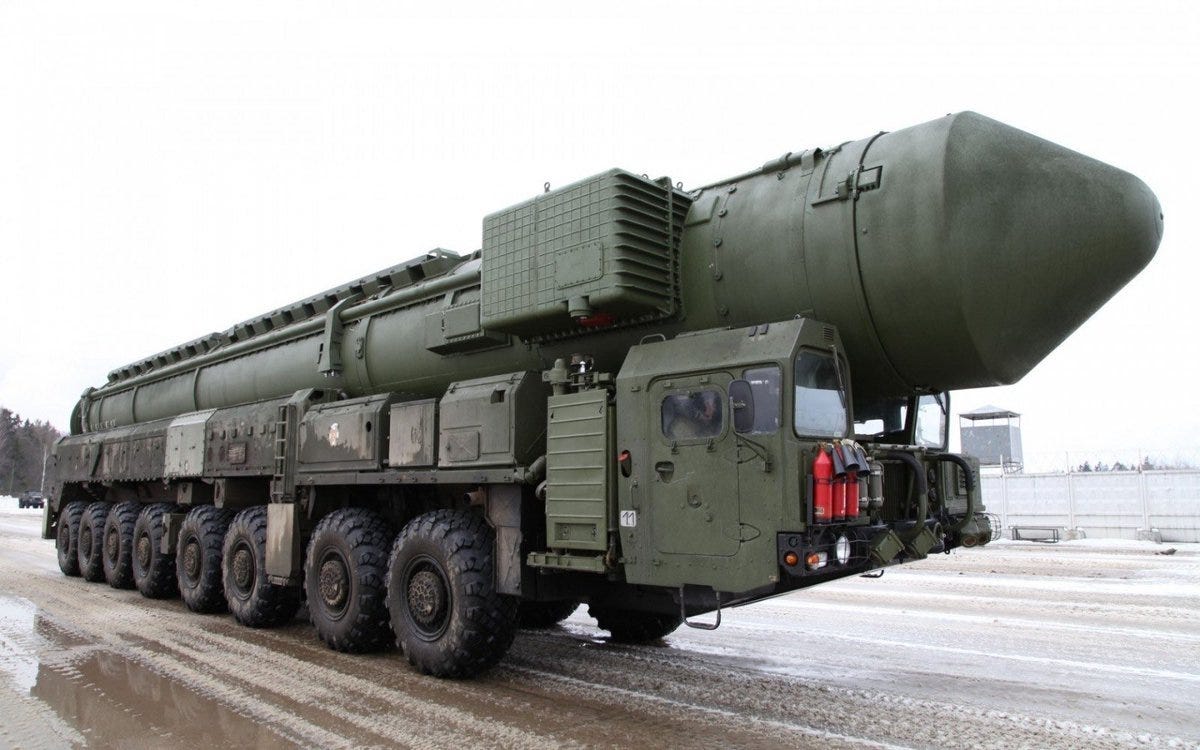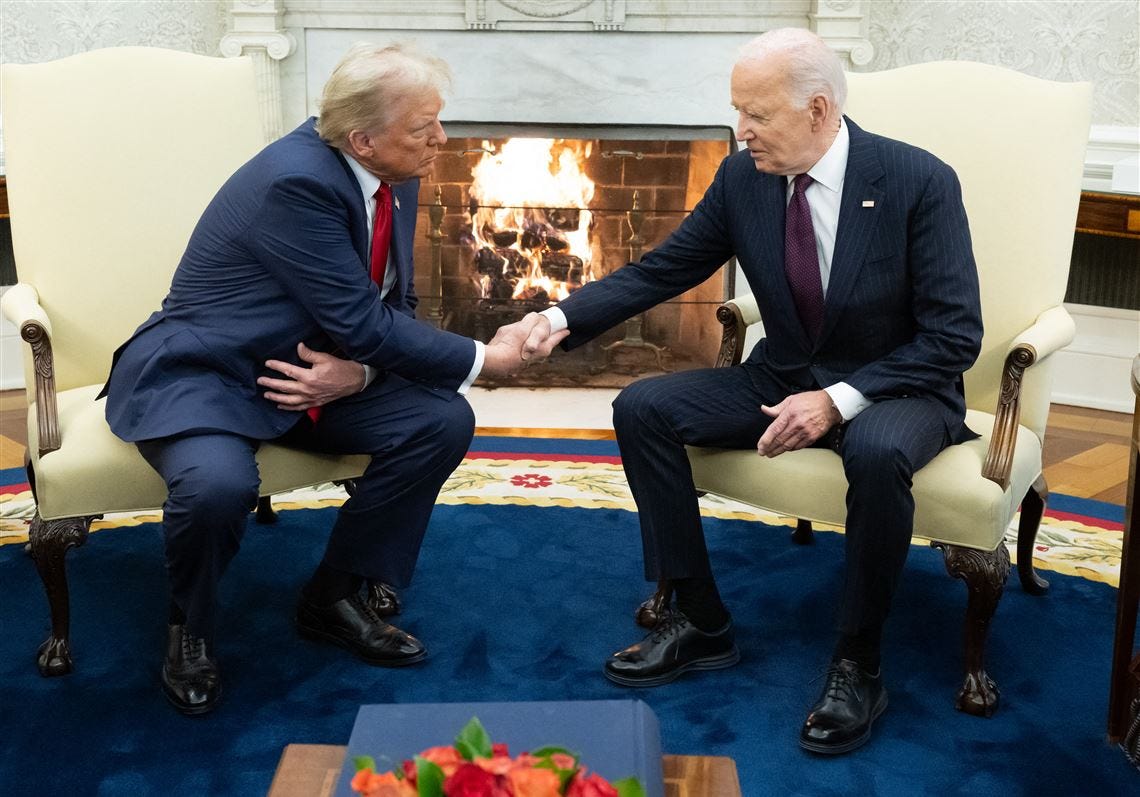Terminal Lucidity
In a reckless last gasp to salvage his Ukraine legacy, Biden authorizes NATO missile strikes on Russia-proper. In response arrived a sinister new Russian weapon system—straight out of science fiction.
In the final stages of life, a dying patient may experience a brief period of terminal lucidity. During this pre-mortem surge, the fog of dementia momentarily lifts, revealing a fleeting clarity of thought. Previously unresponsive individuals may exhibit a sudden burst of energy. This phenomenon is often followed shortly by death.
Rejected and moribund after its collective election defeat, the Biden Administration launched a missile strike on an ammunition depot in Russia’s Bryansk region on Tuesday, November 19th. The following day, British Prime Minister Keir Starmer directed UK military units, with the assistance of their Ukrainian proxies, to attack the Russian Group of Forces Command Center in the Kursk region. This UK combined assault featured an unknown number of Storm Shadow missiles (perhaps four) combined with a larger volley of HIMARS artillery shells. According to President Vladimir Putin, while both strikes failed to achieve their objectives, the second attack resulted in casualties among Russian service members.
In the wake of their attacks on Russian territory, Western sources allege that several so-called "North Korean generals" were killed in the Kursk attack. However, the narrative surrounding North Korean troops has all the hallmarks of myth-making, echoing the Bigfoot legend or the false claims of WMDs in Iraq. Commentators who amplify such unsubstantiated allegations as facts, align themselves with Western information warfare and should be treated as unreliable sources—disconnected from material reality. Perhaps one day North Korean soldiers will appear in the Donbass but as of this writing, there is not a shred of evidence to support this claim. Yet, for those committed to defending the War Party, extremism in peddling these unconfirmed narratives is no vice and will certainly advance their careers. What is more probable is that Russia is importing cheap North Korean labour in an attempt to cool down their overheating economy.
Putin’s Riposte
Despite Western claims that they have trampled all over a multitude of Russia’s pathetic redlines, in fact Putin has only declared two: no overt NATO troops in Ukraine and no long-distance missile attacks on Russia-proper. The term “long-distance” does contain a safe measure of ambiguity and yet Russia responded harshly to recent attacks of a modest range by firing a multistage ballistic missile. Just 30 minutes before the launch, Russian officials complied with nuclear safety protocols by announcing that the trajectory of the intermediate-range ballistic missile (IRBM) they were about to launch would be towards Ukraine and not the US or one of their vassals in Europe. Apparently Russia gave no details about the nature of the warheads this missile would be carrying, leaving NATO officials wondering if the first nuclear strike in anger since Nagasaki was about to take place.
From President Putin’s speech which followed the attack:
In response to the deployment of American and British long-range weapons, on November 21, the Russian Armed Forces delivered a combined strike on a facility within Ukraine’s defence industrial complex. In field conditions, we also carried out tests of one of Russia’s latest medium-range missile systems – in this case, carrying a non-nuclear hypersonic ballistic missile that our engineers named Oreshnik. The tests were successful, achieving the intended objective of the launch. In the city of Dnepropetrovsk, Ukraine, one of the largest and most famous industrial complexes from the Soviet Union era, which continues to produce missiles and other armaments, was hit.
<…>
We will determine the targets during further tests of our advanced missile systems based on the threats to the security of the Russian Federation. We consider ourselves entitled to use our weapons against military facilities of those countries that allow to use their weapons against our facilities, and in case of an escalation of aggressive actions, we will respond decisively and in mirror-like manner. I recommend that the ruling elites of the countries that are hatching plans to use their military contingents against Russia seriously consider this.
The Production Union Southern Machine-Building Plant, or Pivdenmash (Yuzhmash in Russian), has a storied history as a cornerstone of Soviet aerospace and defense innovation. Located in Dnipro (formerly Dnepropetrovsk), this facility was instrumental in the design and production of ballistic nuclear missiles during the Cold War. Notably, the West branded many Soviet missile systems with distinctive monikers, such as the SS-3 “Shyster,” SS-4 “Sandal,” SS-17 “Spanker,” and the ominous SS-18 “Satan.”
Pivdenmash is renowned for its subterranean infrastructure, boasting extensive underground bunkers and workspaces designed to safeguard critical operations from even nuclear attack. These engineering marvels of Soviet military architecture served as inspiration for similar facilities in countries like North Korea and Iran. Since the onset of the Ukraine war, the facility has been a recurring target for Russian strikes. Though its current capabilities remain uncertain after years of post-Soviet decline, there is speculation that NATO has been aiding Ukraine in developing indigenous long-range missile and drone technologies within these deep underground catacombs.
The weapon Russia deployed in its recent attack on the Pivdenmash plant has ignited widespread speculation. President Putin identified it as the "Oreshnik" system (Russian for "hazel tree"), a hypersonic ballistic missile capable of carrying six multiple independently targetable re-entry vehicles (MIRVs). Each MIRV can be armed with several nuclear warheads or even kinetic projectiles composed of tungsten rods. These rods are engineered to obliterate underground facilities by harnessing sheer kinetic energy rather than relying on explosives. Plummeting towards their underworld targets at Mach 10, the rods glow ever brighter, manifesting their own eerie version of terminal lucidity. Although the use of tungsten rod warheads remains unconfirmed, the concept has long-standing roots in science fiction.
Project Thor: Rods From God
Project Thor, often referred to as "Rods from God," is a proposed US space-based weapons system that used kinetic energy rather than explosives to destroy targets on Earth. In 2006, The New York Times shed light on the motivations driving development of such systems:
In an age of rogue regimes and pre-emptive war, states developing clandestine nuclear programs know better than to leave them in plain sight. Anxious to ward off an American or Israeli attack, Iran, for example, appears to have buried its uranium-enrichment halls under 30 feet of earth and concrete. No doubt, canny proliferators will soon dig even deeper and better-armored holes.
But if they dig deeper, we can always go higher: hence the call for the “Rods From God.” More properly known as hypervelocity rod bundles, these weapons would simply be slender solid tungsten cylinders, 20 or 30 feet long and one or two feet in diameter. The rods would be sent into space and fired from satellites at bunkers on the ground, which they would hit at speeds of more than 10,000 feet per second, penetrating deep into the earth without any explosives. The idea is far from new. Jerry Pournelle, a science-fiction writer and space-weapons expert, conceived it while working for Boeing in the late 1950s; he called the weapon Thor, and as he explained in an interview, “People periodically rediscover it.”
In 2002, Raytheon filed for a patent on a space-based tungsten rod bunker buster weapon based on the “Rods from God” concept. The warheads contain bundled tungsten rods which are released by explosives:
Tungsten, whose name derives from the Swedish term "tung sten" meaning "heavy stone," is a rare and incredibly dense metal with exceptional physical properties. It boasts the highest melting point of any metal, making it ideal for high-speed kinetic projectiles that must withstand immense heat and pressure during atmospheric re-entry and impact. However, tungsten's significant weight presents logistical challenges, particularly for ballistic missile delivery systems, where payload capacity is a critical limitation.
The original US "Rods from God" concept envisioned a space-based system where tungsten rods could be stockpiled over time using multiple launches, bypassing the weight constraints of single-use terrestrial delivery. Such a system would be capable of rapid, precision strikes without warning, leveraging Earth's gravity to amplify destructive potential. Russia's potential adaptation represents a more immediate and pragmatic approach, aligning with existing missile technology while testing the operational viability of kinetic energy weapons for near-term use. The Russian version must use far fewer rods than the US space-based concept, and doubts remains on the weapon's effectiveness and the depth of penetration these rods could achieve against hardened targets like underground reinforced concrete bunkers.
The Oreshnik system, with an estimated flight range of 5,000 kilometers, clearly places all of Europe within its targeting zone, regardless of speculation about its warhead types. This capability grants Russia an asymmetrical advantage, enabling it to conduct high-stakes strategic strikes that challenge traditional deterrence frameworks. By projecting power while intentionally staying below the nuclear threshold, Russia pushes the boundaries of conventional deterrence strategies.
Nuclear Strategy: Europe First
It was always unlikely that Russia would respond to a conventional NATO missile attack with nuclear weapons. Rooted in Soviet-era doctrine, Russia’s military strategy is built on the principle of symmetrical or "tit-for-tat" responses. This approach prioritizes equivalent countermeasures over escalation to disproportionate or unpredictable actions.
Russia’s use of an intermediate-range ballistic missile (IRBM) against Ukraine conveys two distinct messages. Following the attack, American officials were quick to correct erroneous reports suggesting that Russia had launched an intercontinental ballistic missile (ICBM)—a crucial distinction. By deploying an IRBM, Russia implicitly threatens all of Europe with the Oreshnik weapon system while explicitly excluding the United States from this threat due to the missile’s limited range.
This distinction between Europe and the United States mirrors Cold War-era nuclear strategy. As former Swiss intelligence officer Jacques Baud explains in his 2022 book Operation Z, Europe historically served as a nuclear buffer zone, designed to prevent full-scale escalation toward strategic nuclear exchanges between the United States and Russia:
This suggests that even in the highly improbable scenario of a Russian nuclear attack—such as one targeting Britain—the United States is unlikely to retaliate with a nuclear strike directly on Russian territory. Instead, the U.S. response would likely be more calculated and geographically limited. For instance, it might target Russia’s Black Sea Fleet in Sevastopol, Crimea, or focus on Russian military assets in the Donbass. A direct nuclear strike on Russian soil remains improbable within this strategic framework. Furthermore, as an oligarchy, the U.S. is heavily influenced by its billionaire elite based in cities like New York, Washington D.C., Silicon Valley, and Los Angeles—individuals whose privileged lifestyles would be jeopardized by the catastrophic consequences of a nuclear exchange. This oligarchic influence effectively serves as an informal check on U.S. nuclear policy.
And yet, despite the first wispy clouds of nuclear war gathering, a Coalition of Weakness is forming in Europe. In an example of terminal stupidity, the Northern Group-Ukraine is emerging to resist any efforts by the incoming Trump Administration to bring peace to Europe.
These yapping geopolitical chihuahuas could send their armies to Ukraine tomorrow and try to slay the Russian beasts, and yet they refuse to do so. They have placed themselves into a rhetorical double bind. Out of one side of their mouths, they shout hysterically that Putin is a feral bloodthirsty menace who will soon overrun Europe. Out of the other side they claim Putin is a pushover and that all of his redlines can be safely trampled upon and all of his nuclear sabre rattling should be ignored.
Deep down, this group feels deeply entitled to a blood sacrifice by Trump-supporting Americans, who in their eyes are only fit to fight and die for Europe’s grandiose hallucinations of power. These all-powerful statesmen—in their own heads—squaring up on the peacenik Trump, seem to have forgotten to wear their iconic “pussy hats,” so proudly sported by the resistance during Trump’s first term.
Trump: Co-conspirator in Escalation?
Despite some grumbling in Europe, Donald Trump—who criticized “forever wars” on the campaign trail and referred to President Zelensky as a “huckster”—has been oddly quiet regarding President Biden’s escalation in Ukraine. Given that Biden retains full authority as commander-in-chief for the remaining two months of his term, it is unlikely that Biden would have granted Trump any meaningful input or veto power over such a critical policy decision during their recent meeting. Since Trump has not yet assumed office, it is appropriate for him to refrain from publicly commenting on the escalation.
Interestingly, statements from Representative Mike Waltz of Florida, Trump’s pick for National Security Advisor, suggest a more aggressive stance that aligns with Biden’s current policy. In an interview conducted the day before the election, Waltz hinted that a future Trump Administration might also advocate for "taking the handcuffs off" and enabling Ukrainian proxies to directly attack Russia.
First and foremost, you would enforce the actual energy sanctions on Russia. Russia is essentially a gas station with nukes. Putin is selling more oil and gas now than he did prewar through China and Russia. And you couple that with unleashing our energy, lifting our LNG ban, and his economy and his war machine will dry up very quickly,” Waltz said. “So I think that will get Putin to the table. We have leverage, like taking the handcuffs off of the long-range weapons we provided Ukraine as well. And then, of course, I think we have plenty of leverage with Zelensky to get them to the table.
Waltz’s remarks preceded Trump’s electoral victory. While they may offer a glimpse into the direction of Trump’s national security policy regarding Ukraine and Russia, they cannot be taken to mean Trump shares responsibility for any catastrophic results of Biden’s escalatory strategy. Is it really Trump’s fault that Biden’s terminal lucidity is shining so bright that he is apparently considering providing Ukraine with nuclear weapons?
Like the proverbial cockroach surviving a nuclear holocaust, the myth that Ukraine ever truly possessed nuclear weapons seems indestructible. It is true that Soviet nuclear weapons were once stationed on the territory that became Ukraine. However, North Dakota also has more than 1,250 nuclear weapons located within its state’s limits. If the U.S. were to disintegrate and its states became independent, would that make North Dakota a major nuclear power? Of course not. Neither Ukraine nor North Dakota possessed the launch codes for their nuclear devices, rendering them incapable of actually deploying the weapons. At most, they could attempt to extract enriched uranium or plutonium and try to build their own weapons—an entirely different challenge.
Iran, Syria, and perhaps even Hezbollah will undoubtedly welcome this newfound American enthusiasm for proliferating nuclear weapons to unstable regimes. If the United States opens the door for Ukraine to join the nuclear club, it stands to reason that Russia might respond in kind by supporting its allies in the Middle East with similar geopolitical generosity.
Throughout his term, Biden has positioned himself as America’s "good cop," cajoling allies by warning that any disobedience to America’s diktats will facilitate the return of the "Orange menace." However, with that narrative now exhausted and his presidency stuck in a lame-duck phase, one might ask whether Biden’s apparent terminal lucidity is a calculated strategic reversal with Trump. With the West currently lacking meaningful leverage in negotiations with Russia, could Biden’s seemingly irrational bellicosity be a deliberate act, setting the stage for Trump to wield a new arsenal of dramatic—if clumsy—threats against Putin for upcoming negotiations? In this scenario, Trump can continue to project his carefully cultivated image as a champion of peace, despite loading his cabinet with many neoconservative hawks.











The last paragraph sums up my opinion on the situation. I think Trump encouraged Biden to greenlight long range strikes in Russia in order to escalate to de-escalate. Having Biden do it, so Trump can keep his hands is the icing on the cake for Trump. Trump has publicly said, many times, that he likes to have war hawks around him because they represent the stick in the negotiating process. You can't make a deal without leverage, all you can do is take a deal. Putin needs a reason to negotiate.
I always like your analogies. Very original.
Beyond that, I doubt RU and USA can meaningfully negotiate. RU’s baseline conditions (just to start
a dialogue) are nearly non-starters for the USA.
But even if there was an effort, how could RU trust the USA, who has torn up the vast majority of treaties? The word of a president at this time is meaningless; in Trump’s case it has a shelf life of 4 years.
Ergo, my own thinking is that the war will be fought to its logical conclusion. Ukraine has 2 choices: defeat or (nearly complete) destruction.